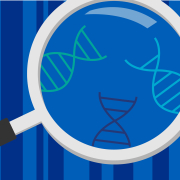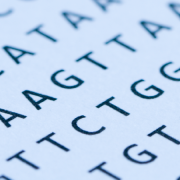Do our genes govern our fate?
A ‘faulty’ gene can result in different outcomes for different people – penetrance and expressivity influence the impact of our genetic code
When we learned genetics at school, it seemed straightforward – a gene for eye colour, a gene for ear lobe shape, a recessive allele, a dominant allele. But the genetics we observe in real life seldom bears much resemblance to Mendel’s peas – see the short TED-Ed animation below for a recap. For example, we see that traits can seem to ‘skip a generation’, though we know genes don’t appear and disappear.
The more we know about the human genome, the more complexity we find. Two sorts of variability called penetrance and expressivity can help to explain why in life, and in medicine, a single dominant gene does not always cause the result we expect.
Penetrance
Penetrance is a measure of the proportion of individuals carrying a specific gene who express the related trait. In other words, it quantifies the relationship between a genotype and the associated phenotype.
In Mendelian genetics, the assumption is that the phenotype is always dictated by the genotype, and for some traits this is true; this is called complete penetrance. An example is Neurofibromatosis type 1, where a faulty gene causes tumours (usually benign) to grow along the nerves of the patient. Everybody who had the faulty gene variant shows some symptoms of the disorder.
However, many genes do not exhibit complete penetrance, and in terms of genetic disease this can mean that a person whose genotype is associated with an illness can be healthy and symptom-free.
The BRCA genes provide a good example of reduced penetrance. Both BRCA1 and BRCA2 are strongly linked to breast and ovarian cancers, but not everyone who carries pathogenic variants of these genes goes on to develop a tumour. The penetrance of BRCA1 would be calculated as the proportion of BRCA1 mutation carriers who develop breast and/or ovarian cancer. This can be calculated using DNA sequencing and from family histories, or more accurately using genotypic and phenotypic information from a large population sample.
While penetrance explains whether or not individuals express a particular trait, it does not apply to the degree of expression, which is known as expressivity.
Expressivity
Expressivity is a qualitative measurement defined as the extent of a given genotype expressed at the phenotypic level. So whereas penetrance measures how often the trait associated with the gene was expressed at all (a yes/no result in each individual), expressivity describes how the particular gene’s effect is manifested.
In a trait with variable expressivity, the phenotype of individuals carrying the gene can be expected to cover a range, in terms of extent or type of characteristics.
In the context of genetic diseases, expressivity can cause variation in the severity of symptoms, or the appearance of different symptoms within a syndrome. A disease where symptoms and severity are fairly consistent between patients with the same genotype would be classed as having narrow expressivity.
Variable expressivity is well exemplified in many syndromes: patients are diagnosed based on a group of characteristics which, when they occur together, indicate a common cause. For example, Marfan syndrome is known to be caused by a mutation in the FBN1 gene, which codes for fibrillin, a key component of connective tissue. Symptoms include being tall with long limbs and digits, but some patients can also have serious eye and heart problems.
Impact on genomic analysis
Both variable expressivity and incomplete penetrance can make genetic analysis more difficult. Before large genomic datasets were available to researchers, it is easy to see how lack of symptoms or differing symptoms could be difficult to interpret for geneticists working primarily from genetic pedigrees.
However, understanding penetrance and expressivity can bring our model of how disease causation works closer to what we observe in the real world. Whether or not a person carrying a particular variant in a gene is expressing symptoms or not – and how severe those symptoms are – may be influenced by the environment and the rest of the patient’s genome. For example, in addition to BRCA1 and BRCA2, it is known that variations in numerous other genes affect breast cancer risk, as well as environmental and lifestyle factors including obesity and alcohol consumption.
–









